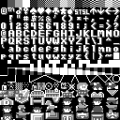Placeholder graphics: Difference between revisions
From NESdev Wiki
Jump to navigationJump to search
(→External links: notified by someone on another wiki) |
(Russian font) |
||
| Line 17: | Line 17: | ||
File:American football field.png|American football field (for Mode 7) by tepples | File:American football field.png|American football field (for Mode 7) by tepples | ||
File:Jroatch-chr-sheet.chr.png|Full CHR sheet by JRoatch | File:Jroatch-chr-sheet.chr.png|Full CHR sheet by JRoatch | ||
File:Russian-font.png|Russian font by qalle | |||
</gallery> | </gallery> | ||
Revision as of 18:18, 20 March 2018
Most programmers can't produce large quantities of high-quality pixel art. So for a game that uses a scrolling map, it is wise to enlist artists. Ordinarily, it goes like this:
- Develop an engine
- Make a playable tech demo
- Attract artists
- Make the game itself, as a total conversion mod of the demo that you produced in step 2
But in order to make the demo, you'll need some art assets to put in your demo. Some people prefer to rip graphics from existing non-free NES games, but it could prove disastrous if enough of these tiles managed to make it into the final release. So it's better to use assets that require nothing more than crediting the author, like these:
External links
- By Chasersgaming on Itch: RPG Assets (NES); Tile Set Pack for NES (CC0 Public Domain)
- OpenGameArt (Various licenses)




